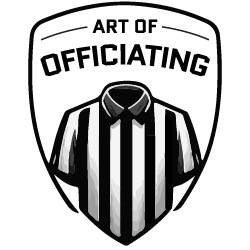There’s a big difference between warning a player about what not to do and guiding them toward what right looks like. Too often, we fall into the habit of saying things like: “That’s holding; if you do it again, I’ll flag you.” The problem? That phrasing suggests you observed a foul and simply chose not to penalize it this time.
When the action is borderline and you want to help the player adjust, use an instruct-to-the-desired-behavior approach instead.
Instead of saying, “If you do it again, I’ll flag you,” a more effective response is to tell the player what you want to see: “Keep your arms inside the torso.” That’s positive communication. You’re painting a picture of correct technique, not threatening a penalty. It may feel like semantics, but it makes a big difference: you’ve warned the player without being negative, and you’ve shared exactly what you need to see to avoid a foul the next time.
This is positive instruction: redirecting behavior by describing what right looks like. It’s correcting behavior without simply mentioning what not to do. And it makes us better officials because our goal is not to “catch” players, it’s to help them play within the rules.
Here are more examples:
A defender takes two steps and then contacts the quarterback. You decide it’s not enough for a flag, but it’s worth addressing. Instead of saying, “That’s roughing, do it again and I’ll flag you,” use positive instruction: “Make sure you hold up when the ball is away.”
After a tackle, players linger near the pile and start jawing at each other. Rather than barking, “Knock it off,” redirect their energy with something constructive: “Way to play football. Back to your huddles.” You’ve acknowledged the action, praised what was legal, and given them a path to disengage.
When a coach crosses the line with a comment, it’s tempting to fire back with: “Say that again and I’ll flag you.” That approach is negative and combative and it usually adds fuel to the fire. A better option is calm but firm: “Would you like to repeat what you just said?” This puts the responsibility back on the coach, gives him a chance to reconsider, and often de-escalates the situation. You’re not threatening, you’re inviting him to reflect. If he doubles down, then you’ve got clear grounds to act.
Positive instruction isn’t only about redirecting borderline behavior. It’s also about recognizing when players get it right. Loudly acknowledging good decisions can be just as powerful as correcting bad ones.
When a defender pulls up and avoids slamming into the passer after the ball is released, don’t let that go unnoticed. Say it loud enough for others to hear: “55, good job holding up!“
If a player helps an opponent off the ground, a quick “81, that’s great sportsmanship. Thank you!” reinforces the behavior you want to see more of.
When a runner is clearly giving up and heading out of bounds, a defender who slows down instead of finishing with a hit deserves credit. “Hey 32, I appreciate that. Great job holding up on that play!” lets everyone know that the action was right.
By praising correct actions in real time, you’re shaping the culture on the field. Players learn that restraint and sportsmanship aren’t just expected, they’re noticed. Coaches hear it too, and it builds credibility for you and your crew.
Quiz
Read the quiz stem and then choose the best answer. (Choose all that apply.)
3/5 from the A-35. A55 lines up in the backfield directly behind quarterback A12. A12 throws a backward pass to A55, who catches the ball on the A-31. A55 is hit and fumbles at the A-31, and the ball goes straight up. A43 bats the ball in flight at the A-32. A55 recovers the ball at the A-34.
- A55 is guilty of illegal touching
- A43 is guilty of illegal batting
- 4/6 from the A-34
Review Rules 7-5-6, 9-7-2
